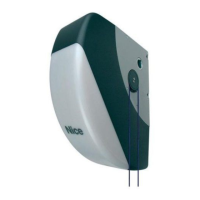12 – ENGLISH
4.3.1 FT210B photosensor
The FT210B photosensor combines in a single device a force lim-
iting system (type C, in accordance with the EN12453 standard)
and a presence sensor that detects obstacles on the line of sight
between the TX transmitter and RX receiver (type D, in accordance
with the EN12453 standard). In the FT210B photosensor, the sig-
nals regarding the status of the sensitive edge are sent through the
photocell range, integrating the 2 systems in a single device. The
transmitting element located on the moving leaf is battery-pow-
ered, which eliminates visually unpleasant connection systems;
special circuits reduce battery consumption, ensuring up to 15
years’ life (see estimation details in the product’s instructions).
A single FT210B device combined with a sensitive edge (TCB65,
for example) allows for attaining the level of safety of the “primary
edge” required by the EN12453 standard for all “types of use” and
“types of activation”.
The FT210B photosensor combined with the “resistive” sensitive
edges (8.2 kΩ) is safe against faults (category 3 pursuant to the
EN 13849-1 standard). It is equipped with a special anti-collision
circuit to prevent interference with other detectors, even not syn-
chronised, and allows for adding other photocells; for example,
in case of transit of heavy vehicles, where a second photocell is
normally positioned 1 m above the ground.
l
Consult the FT210B instruction manual for further
information on the connection and addressing
methods.
FINAL CHECKS AND START-UP
5
5 FINAL CHECKS AND START-UP
It is advisable to position the leaf approximately halfway along its
path before starting the automation check and start-up phases, so
that the leaf is free to open and close.
5.1 POWER SUPPLY CONNECTION
a
The power supply connections must only be made
by qualied and experienced personnel possessing
the necessary requirements and in full conformity
to the laws, regulations and standards in force.
As soon as the product is powered, a few simple checks should
be carried out:
1. check that the BlueBus LED ashes regularly with one ash
per second.
2. make sure that the LEDs on the photocells (both the TX and
RX) also ash; the type of ashing is irrelevant, since it de-
pends on other factors.
3. check that the warning light connected to the FLASH output
is off.
4. check that the courtesy light is off.
If the above conditions are not satised, immediately switch off the
power supply to the control unit and carefully check the electrical
connections.
Further useful information on searching and diagnosing faults is
included in the “Troubleshooting” paragraph.
5.2 DEVICE LEARNING
Once the power supply has been connected, the control unit must
recognise the devices connected to the “BlueBUS” and “STOP”
inputs. Prior to this phase, LEDs “L1” and “L2” will ash to signal
that the device learning procedure must be performed.
m
The learning phase must be carried out even if no
device is connected to the control unit.
To do this:
1. simultaneously press and hold the
p
and
o
buttons
2. release the buttons when LEDs “L1” and “L2” start ashing
quickly (after roughly 3 seconds)
3. wait a few seconds until the control unit has completed the
device learning phase
4. once this phase terminates, the “Stop” LED must be lit and
LEDs “L1” and “L2” must switch off (LEDs “L3” and “L4”
could start ashing).
FUSE
LED
FUSE
Flash Alarm
Bluebus
StopSbSOpenLight
Light
L1
L2
16
The self-learning phase of the connected devices can be repeated
at any time also after the installation, for example whenever a de-
vice must be added.
5.3 LEARNING OF THE DOOR OPENING AND
CLOSING POSITIONS
Once the devices have been learned, the control unit must recog-
nise the door opening and closing positions, in addition to a few
optional positions.
There are 6 positions in total:
Before this phase, LEDs “L3” and “L4” ash (“Figure 17”) to sig-
nal that the positions must be learned.
FUSE
LED
FUSE
Flash Alarm
Bluebus
StopSbSOpenLight
Light
L3
L4
17

